- Joined
- Jul 1, 2014
- Messages
- 3,723 (0.95/day)
EK Waterblocks had been the subject of more than one article over the recent months here at TechPowerUp, wherein we broke news about top management (at the time) having parted ways with the company and this in turn led to speculation about how this would affect the indubitable leader in market share when it comes to DIY watercooling today. Perhaps they felt as much, and had an entire suite full of products to show off at Computex this year. The products showcased here, and in another separate news post upcoming, are a mixture of updates to existing product lines as well as expansion of said lineups to offer customers more options from the company than before.
We began our look with the new Velocity CPU block. Those who kept up with the subject would remember EK recently admitted they could have, and should have, done better with their offering for AMD's sTR4 socket (Threadripper platform) and had recently shown off a new cold plate design to improve on thermal performance. The new Velocity sTR4 takes advantage of this new cold plate and is available in three different top offerings of acetal with a frosted plexi lining to diffuse lighting by the side, a polished plexi top, and a full nickel-plated brass metal top- all of which use the same nickel-plated copper cold plate. Indeed, the Velocity tagline is now used for their entire range of new CPU blocks that share a similar ID for the smaller CPU sockets as well, with a cold plate that looks similar to that of the older Supremacy EVO but we will definitely take a closer look in upcoming reviews. EK did tell us that the new Velocity CPU blocks are one-piece blocks not meant to be taken apart and customized for different socket types. There are a lot of smaller aesthetic changes here including beveled edges, corner cutouts and arrows to indicate the recommended plumbing layout. One other interesting thing to point out here is that EK also designed a cold plate variation to be used with delidded Intel mainstream CPUs via a small circular section jutting outwards as seen in the images below. All of the new Velocity CPU blocks also come with a new mounting plate that supposedly improves on both looks and material strength. Oh, all of these also have RGB lighting incorporated even with the metal top version- the revised EK badge on these blocks is backlit after all.






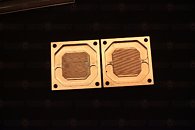

Monoblocks and full-cover GPU water blocks were not left behind, with these falling under the new Wave name, with the latter getting more of an aesthetic change than anything else. Notice the top now having a metal trim on two sides for flair, allowing more branding and product recognition- be it backlit or otherwise. This was shown off by the inclusion of some example Wave GPU blocks and backplates that have the InWin logo on them, as meant to be used in collaboration projects. These Wave blocks/backplates will also get the new badge treatment, and note that the new monoblocks will use a simplified cooling engine (as with the Velocity CPU blocks) optimizing coolant flow for a cleaner look. Whether or not this affects thermal performance remains to be seen, but EK does seem confident in the new lineup here.


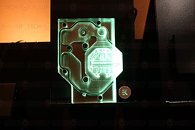

Next on the line to get updated were the EK-Vardar fans, which had an RGB version join their ranks very recently. At Computex, EK also showed off the Vardar-X3M (Extreme, get it?) which is a rugged version of the original Vardar fans (the -ER ones, to be specific) from 2014. As seen in the images below, the fans have removable, thick rubber dampening mounts at the corners that are available in different colors. These mounts jut outwards slightly just that the frame is essentially "floating" when it comes to the case/radiator, thus isolating it further from potential vibrations. The impeller is a new design as well, with a clear housing for RGB but designed with performance foremost in mind. The individual blades are visibly different from the rest of the Vardar fans, and we also see a separate, daisychained cable for the LEDs coming out the back. EK assured us that the retail units will have black sleeving on the cables, although they are considering making a similar version for the Furious Vardar higher-speed versions that are visually distinguished via a red fan cable.


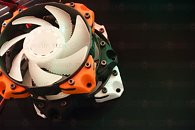

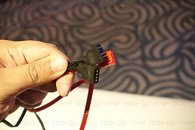
The EK-Cryofuel range of coolants received an update as well, and this time it was their take on the opaque coolant trend that has been catching on in the past few years. Scarce few have had success, with some failing hard, but EK says they have tested all the colors shown for over an year without any issue. These are nanoparticle dispersions, with an average nanoparticle cluster size of 300 nm, and I also spoke to several beta testers who all had only good things to say thus far. Everything bodes well for the Cryofuel Solid thus, and we can only hope it remains so once the range is released. EK is working on a solid black version as well, but that is harder to achieve and is further down the line when it comes to eventual release- if at all.
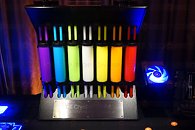
If there was one product that EK have not really had success in, it would be AIOs. The EK-Predator had a lot of promise but fell prey to a bad batch of rubber O-rings and QC issues that resulted in leaks, quick updates and eventual EOL status. This was replaced by the EK-MLC Phoenix that was priced higher than the market deemed it appropriate, and frankly was treated as a stop-gap measure until the real replacement was ready. We saw this at Computex, in the form of a new radiator/fan/pump/reservoir unit that will eventually be paired with tubing, coolant and the new Velocity CPU block. The radiator has a new design scheme, with similar sloped edges as with the CPU block and orange rubber dampeners that match the company logo while being functional as well. The fans included here are the new Vardar RGB variant, and the radiator frame has an EK logo cutout on the side which, as you may well have guessed, will also be backlit. EK did add that the retail units will have internal cable management channels such that the end user will not have to see a lot of cables everywhere owing to the multiple power and LED cables here.




Their copper lineup was not the only thing to get love at Computex, and EK stressed multiple times that their aluminum-based Fluid Gaming brand will continue to be a strong focus for them. Indeed, they had a vast number of new products here as well beginning with a second AIO, nicknamed Hydra, offering that aims to use components from the Fluid Gaming line to offer a more value-oriented cooler for the masses. We see a new pump/CPU block combo unit here thus differentiating it from the other AIO wherein the pump and dedicated reservoir are alongside the radiator. A quick visual look shows what is possibly a dual-chamber design on the pump/block unit thus helping EK skirt past relevant Asetek patents that may have otherwise prevented sales in some regions.
The standalone kits and components in the Fluid Gaming brand also got updates, which were mostly visual and based on customer feedback. We see CPU blocks with different color options to the brushed metal top plate and a visual overhaul to match the rest of the Velocity series (thus making these the Velocity AX), as well as a new series that uses ribbed aluminum tops in various anodized color options. These are purely for looks, mind you, but they do match the aluminum fittings for soft- and hard-tubing alike. The GPU blocks got a similar design with the ribbed faux-heatsink design, but then EK also showed off even more designs that did make me question whether they had a clear approach here or not. It did appear that EK was looking to crowdsource opinions before finalizing designs, and they also mentioned that the pricing for the new Fluid Gaming range will be more amenable than the recent additions that were not as budget-friendly as they should have been. Finally, EK is working with partners in the industry- InWin, for example- to offer a whole series of EK Fluid Gaming systems that can be customized for the hardware and cooling while using InWin cases. An example system at their suite used the InWin 101-C and a Ryzen 5-based system with an NVIDIA GTX 1060 which, coupled with the Fluid Gaming watercooling, is a good balance of performance and price.





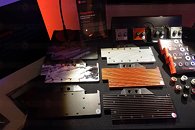

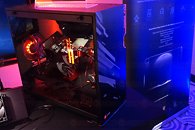
Lastly, EK also showed off updates to their industrial products that are intended for server rack applications, for example. These involve an updated EK-Annihilator EX/EP CPU water block in both square and narrow ILM variants (Intel LGA 3647) that are part of a 2U cooling system involving their SPC-60 pumps and internally placed radiators and smaller reservoirs. The new Annihilator blocks retain the side-mounted G1/8" thread option that allows for a lower profile than with the mainstream options, and EK said they are in a position to provide custom cooling solutions for rack mounts and even workstation servers. This latter application can also make use of similarly designed GPU/ASIC blocks, which allow for a manifold of quick disconnects and multiple GPUs in a render farm, for example, or even for AI/machine learning processors in vehicles.


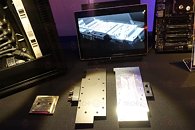

View at TechPowerUp Main Site
We began our look with the new Velocity CPU block. Those who kept up with the subject would remember EK recently admitted they could have, and should have, done better with their offering for AMD's sTR4 socket (Threadripper platform) and had recently shown off a new cold plate design to improve on thermal performance. The new Velocity sTR4 takes advantage of this new cold plate and is available in three different top offerings of acetal with a frosted plexi lining to diffuse lighting by the side, a polished plexi top, and a full nickel-plated brass metal top- all of which use the same nickel-plated copper cold plate. Indeed, the Velocity tagline is now used for their entire range of new CPU blocks that share a similar ID for the smaller CPU sockets as well, with a cold plate that looks similar to that of the older Supremacy EVO but we will definitely take a closer look in upcoming reviews. EK did tell us that the new Velocity CPU blocks are one-piece blocks not meant to be taken apart and customized for different socket types. There are a lot of smaller aesthetic changes here including beveled edges, corner cutouts and arrows to indicate the recommended plumbing layout. One other interesting thing to point out here is that EK also designed a cold plate variation to be used with delidded Intel mainstream CPUs via a small circular section jutting outwards as seen in the images below. All of the new Velocity CPU blocks also come with a new mounting plate that supposedly improves on both looks and material strength. Oh, all of these also have RGB lighting incorporated even with the metal top version- the revised EK badge on these blocks is backlit after all.








Monoblocks and full-cover GPU water blocks were not left behind, with these falling under the new Wave name, with the latter getting more of an aesthetic change than anything else. Notice the top now having a metal trim on two sides for flair, allowing more branding and product recognition- be it backlit or otherwise. This was shown off by the inclusion of some example Wave GPU blocks and backplates that have the InWin logo on them, as meant to be used in collaboration projects. These Wave blocks/backplates will also get the new badge treatment, and note that the new monoblocks will use a simplified cooling engine (as with the Velocity CPU blocks) optimizing coolant flow for a cleaner look. Whether or not this affects thermal performance remains to be seen, but EK does seem confident in the new lineup here.




Next on the line to get updated were the EK-Vardar fans, which had an RGB version join their ranks very recently. At Computex, EK also showed off the Vardar-X3M (Extreme, get it?) which is a rugged version of the original Vardar fans (the -ER ones, to be specific) from 2014. As seen in the images below, the fans have removable, thick rubber dampening mounts at the corners that are available in different colors. These mounts jut outwards slightly just that the frame is essentially "floating" when it comes to the case/radiator, thus isolating it further from potential vibrations. The impeller is a new design as well, with a clear housing for RGB but designed with performance foremost in mind. The individual blades are visibly different from the rest of the Vardar fans, and we also see a separate, daisychained cable for the LEDs coming out the back. EK assured us that the retail units will have black sleeving on the cables, although they are considering making a similar version for the Furious Vardar higher-speed versions that are visually distinguished via a red fan cable.





The EK-Cryofuel range of coolants received an update as well, and this time it was their take on the opaque coolant trend that has been catching on in the past few years. Scarce few have had success, with some failing hard, but EK says they have tested all the colors shown for over an year without any issue. These are nanoparticle dispersions, with an average nanoparticle cluster size of 300 nm, and I also spoke to several beta testers who all had only good things to say thus far. Everything bodes well for the Cryofuel Solid thus, and we can only hope it remains so once the range is released. EK is working on a solid black version as well, but that is harder to achieve and is further down the line when it comes to eventual release- if at all.

If there was one product that EK have not really had success in, it would be AIOs. The EK-Predator had a lot of promise but fell prey to a bad batch of rubber O-rings and QC issues that resulted in leaks, quick updates and eventual EOL status. This was replaced by the EK-MLC Phoenix that was priced higher than the market deemed it appropriate, and frankly was treated as a stop-gap measure until the real replacement was ready. We saw this at Computex, in the form of a new radiator/fan/pump/reservoir unit that will eventually be paired with tubing, coolant and the new Velocity CPU block. The radiator has a new design scheme, with similar sloped edges as with the CPU block and orange rubber dampeners that match the company logo while being functional as well. The fans included here are the new Vardar RGB variant, and the radiator frame has an EK logo cutout on the side which, as you may well have guessed, will also be backlit. EK did add that the retail units will have internal cable management channels such that the end user will not have to see a lot of cables everywhere owing to the multiple power and LED cables here.




Their copper lineup was not the only thing to get love at Computex, and EK stressed multiple times that their aluminum-based Fluid Gaming brand will continue to be a strong focus for them. Indeed, they had a vast number of new products here as well beginning with a second AIO, nicknamed Hydra, offering that aims to use components from the Fluid Gaming line to offer a more value-oriented cooler for the masses. We see a new pump/CPU block combo unit here thus differentiating it from the other AIO wherein the pump and dedicated reservoir are alongside the radiator. A quick visual look shows what is possibly a dual-chamber design on the pump/block unit thus helping EK skirt past relevant Asetek patents that may have otherwise prevented sales in some regions.
The standalone kits and components in the Fluid Gaming brand also got updates, which were mostly visual and based on customer feedback. We see CPU blocks with different color options to the brushed metal top plate and a visual overhaul to match the rest of the Velocity series (thus making these the Velocity AX), as well as a new series that uses ribbed aluminum tops in various anodized color options. These are purely for looks, mind you, but they do match the aluminum fittings for soft- and hard-tubing alike. The GPU blocks got a similar design with the ribbed faux-heatsink design, but then EK also showed off even more designs that did make me question whether they had a clear approach here or not. It did appear that EK was looking to crowdsource opinions before finalizing designs, and they also mentioned that the pricing for the new Fluid Gaming range will be more amenable than the recent additions that were not as budget-friendly as they should have been. Finally, EK is working with partners in the industry- InWin, for example- to offer a whole series of EK Fluid Gaming systems that can be customized for the hardware and cooling while using InWin cases. An example system at their suite used the InWin 101-C and a Ryzen 5-based system with an NVIDIA GTX 1060 which, coupled with the Fluid Gaming watercooling, is a good balance of performance and price.








Lastly, EK also showed off updates to their industrial products that are intended for server rack applications, for example. These involve an updated EK-Annihilator EX/EP CPU water block in both square and narrow ILM variants (Intel LGA 3647) that are part of a 2U cooling system involving their SPC-60 pumps and internally placed radiators and smaller reservoirs. The new Annihilator blocks retain the side-mounted G1/8" thread option that allows for a lower profile than with the mainstream options, and EK said they are in a position to provide custom cooling solutions for rack mounts and even workstation servers. This latter application can also make use of similarly designed GPU/ASIC blocks, which allow for a manifold of quick disconnects and multiple GPUs in a render farm, for example, or even for AI/machine learning processors in vehicles.




View at TechPowerUp Main Site


